
Orchids are plants that belong to the family Orchidaceae, a diverse and widespread group of flowering plants with blooms that are often colourful and fragrant. Orchids are cosmopolitan plants that are found in almost every habitat on Earth except glaciers. The world's richest diversity of orchid genera and species is found in the tropics.

Vanda, abbreviated in the horticultural trade as V., is a genus in the orchid family, Orchidaceae. There are 90 species, and the genus is commonly cultivated for the marketplace. This genus and its allies are considered to be among the most specifically adapted of all orchids within the Orchidaceae. The genus is highly prized in horticulture for its showy, fragrant, long-lasting, and intensely colorful flowers. Vanda species are widespread across East Asia, Southeast Asia, and New Guinea, with a few species extending into Queensland and some of the islands of the western Pacific.
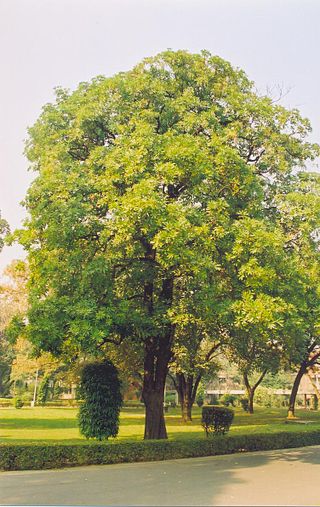
Alstonia is a widespread genus of evergreen trees and shrubs, of the family Apocynaceae. It was named by Robert Brown in 1811, after Charles Alston (1685–1760), professor of botany at Edinburgh from 1716 to 1760.
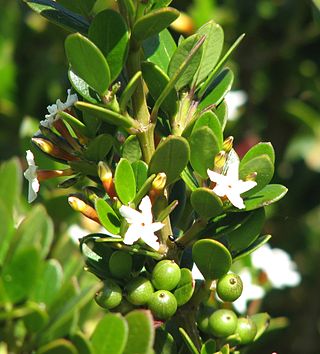
Alyxia is an Australasian genus of flowering plant in the dogbane family, Apocynaceae. It contains at present 106 species, but Alyxia stellata and A. tisserantii are very variable, might be cryptic species complexes, and are need of further study. It consists of shrubby, climbing or scrambling plants. This genus occurs in China, the Himalayas, Southeast Asia, Australia, New Caledonia and the Pacific Islands. There are 14 species in Australia, 21 in New Caledonia and 7 in the other Pacific Islands, including Hawaiʻi.

Acampe, abbreviated as Acp in horticultural trade, is a genus of monopodial, epiphytic vandaceous species of orchids, distributed from tropical Asia from India, eastwards to China and southwards to Malaysia, and the Philippines as well as from tropical Africa, Madagascar and islands of the Indian Ocean. The name Acampe was derived from the Greek word akampas, meaning "rigid", referring to the small, brittle, inflexible flowers.

Arundina graminifolia is a species of orchid and the sole accepted species of the genus Arundina. This tropical Asiatic genus extends from Myanmar, India, Sri Lanka, Nepal, Thailand, Vietnam, the Ryukyu Islands, Malaysia, Singapore, China to Indonesia, the Philippines and New Guinea. It has become naturalized in Réunion, Fiji, French Polynesia, Micronesia, the West Indies, Costa Rica, Panama, Belize, and Hawaii. It is also called bamboo orchid.

Anoectochilus, commonly known as marbled jewel orchids or filigree orchids, is a genus of about fifty species in the orchid family Orchidaceae. They are terrestrial herbs with a creeping rhizome, an upright flowering stem and dark coloured leaves with contrasting veins. The flowers are relatively large and have a large labellum, markedly different from the sepals and petals.

Corybas, commonly known as helmet orchids, is a genus of about 120 species of plants in the orchid family, Orchidaceae. Helmet orchids are small, perennial, deciduous herbs and are nearly always terrestrial. They have a single leaf at their base and a single flower on a short stalk, the flower dominated by its large dorsal sepal and labellum. Species of Corybas are found in Australia, New Zealand, New Guinea, Southeast Asia, the Himalayas, southern China, many Pacific islands and a few sub-Antarctic islands.

Hydnocarpus annamensis is a tree in the Achariaceae family. It is found in Thailand, Cambodia, Vietnam, southern Yunnan and southern Guangxi in Zhōngguó/China. It is threatened by habitat loss. The plant produces low-quality wood and its fruits are used in traditional medicine.

The genus Arachnis, abbreviated as Arach in horticultural trade, is a member of the orchid family (Orchidaceae), consisting of more than 20 species native to China, India, Southeast Asia, Indonesia, the Philippines, New Guinea, and the Solomon Islands.

Rhynchostylis retusa is an orchid, belonging to the Vanda alliance. The inflorescence is a pendant raceme, consisting of more than 100 pink-spotted white flowers. The plant has a short, stout, creeping stem carrying up to 12, curved, fleshy, deeply channeled, keeled, retuse apically leaves and blooms on an axillary pendant to 60 cm (24 in) long, racemose, densely flowered, cylindrical inflorescence that occurs in the winter and early spring. It is famous for its use as a hair-ornament worn by Assamese women during folk dance Bihu on the onset of spring.

Dendrobium pulchellum is an orchid is native to Southeast Asia. This stunning plant blooms from the completion of winter into early spring. This is due to Dendrobium requiring cooler temperatures for growth and development.

Geodorum, commonly known as shepherds' crooks or 地宝兰属 , is a genus of eight species of flowering plants in the orchid family, Orchidaceae. They are deciduous, terrestrial herbs with underground pseudobulbs, broad, pleated leaves and small to medium-sized, tube-shaped or bell-shaped flowers on a flowering stem with a drooping end. Species in this genus are found in southern Japan, tropical Asia, Australia and islands of the southwest Pacific Ocean.

Micropera, commonly known as dismal orchids or 小囊兰属 is a genus of about twenty species of flowering plants from the orchid family, Orchidaceae. Plants in this genus are large epiphytes with thick roots, long, fibrous stems, linear leaves and whitish or yellow, non-resupinate flowers. The sepals and petals are similar to each other and the labellum is shoe-shaped or sac-like and has three lobes. It is found from Tibet to tropical Asia and the western Pacific Ocean.

Many areas of Vietnam are under protection. While the national reserves cover small areas of scientific significance with restricted access, the national parks also cover wetlands of Ramsar designated areas and BirdLife International inscribed bird areas. The largest of the national parks initially covered were the Cúc Phương National Park, the Cát Tiên National Park, and the Côn Đảo National Park which to start with were forest areas cum reserves or prohibited areas. The objective for creating national parks was to allow access to the reserved areas as a part of ecotourism and cultural needs with full attention to the basic approach of conservation of natural environmental resources.
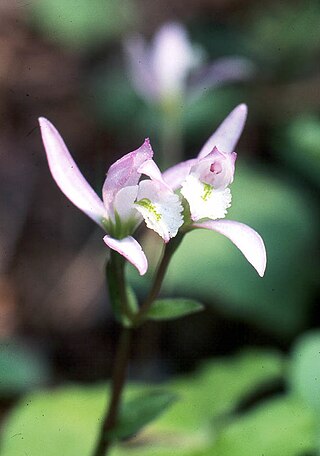
Triphora trianthophoros, the threebirds or three birds orchid, or nodding pogonia, is a species of terrestrial orchid native to eastern North America.
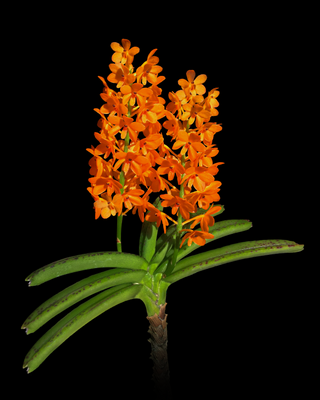
Vanda garayi, or Garay's ascocentrum, is a small monopodial epiphytic orchid native to semi-deciduous and deciduous dry lowland forests of Thailand, Laos, and Sumatra.
Pelatantheria rivesii is a species of epiphytic or lithophytic orchid occurring in China, Laos and Vietnam. This species closely resembles Pelatantheria insectifera bothin its vegetative and generative morphology. The commonly branched stems may reach lengths of 1 m and diameters of 7 mm. Few flowers are produced during October on short racemes, which do not exceed the length of the leaves. The flowers are small and fleshy and the sepals and petals are pale yellow and bear striped. The labellum is pink.

Vanda dives is a species of epiphytic orchid native to Vietnam and Laos.
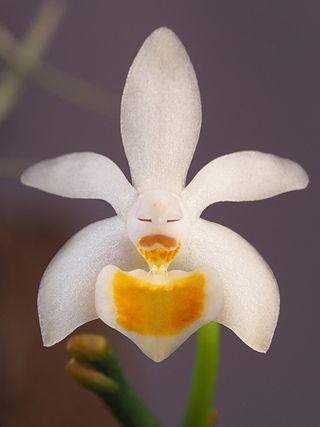
Phalaenopsis malipoensis, also known as 麻栗坡蝴蝶兰 in Chinese, is a species of orchid native to South-Central China and Vietnam. The specific epithet malipoensis refers to the Chinese locality Malipo, which is a hotspot for biodiversity research in Yunnan Province, China.





















